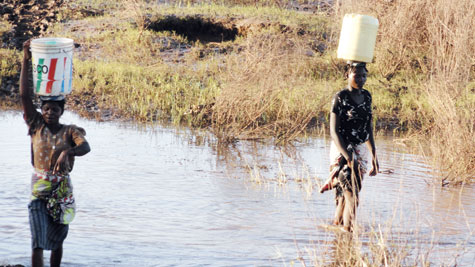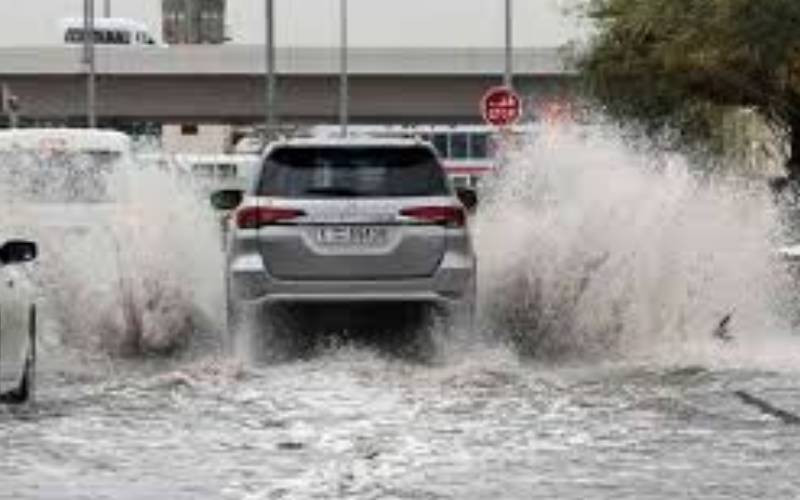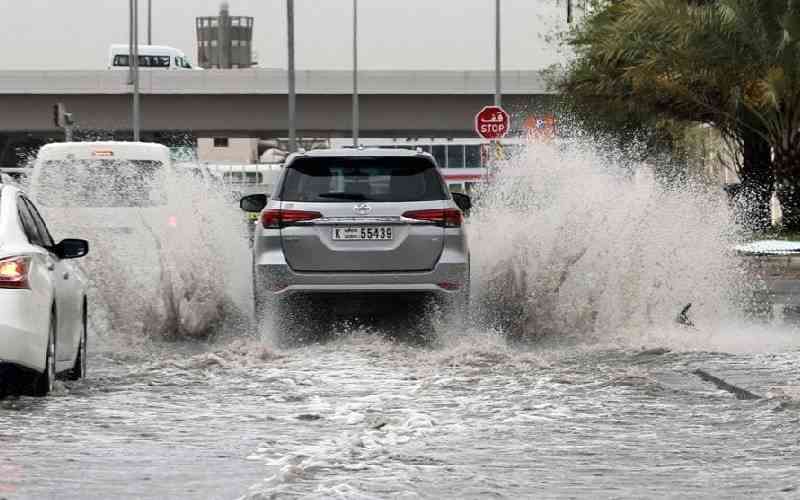By Jeckonia Otieno
 |
|
Photo:Standard |
A sufuria of beans is boiling on the fire; four children, their faces full of anticipation, are huddled around it. These are the grandchildren of Mama Kanze Decha and it is this small sufuria of beans that is supposed to be their supper.
This is a typical scene at the campsite in Kavunyalalo and Paziani areas where floods have wrought havoc forcing the locals to move to higher ground.
The irony of the situation is that the surrounding area — actually the whole of coastal region — is dry. The floods that have displaced around 200 people in the area have been caused by the rains experienced in far away central Kenya and Nairobi.
The water flowing downstream has burst the banks of River Sabaki — known as the Athi upstream — in the coastal plains. The situation is the same in Kisiwani and Mbogolo areas also along the same river.
Rophus Shuma, an elder says villagers were woken up at night as the floods started spreading towards their homes. By morning, they say, the water had risen so high that people were forced to relocate in order to cheat death.
“We realised as days passed by that the level of the river continued to rise despite the dry spell that this area is experiencing,” says Shuma.
He further notes that their semi-permanent mud houses were swept away as they watched, after they had moved to the current locale.
The villagers had prepared the land for planting but they have not planted yet due to the delayed rains. Now the grief has to do with the fact that instead of rainwater they pined for, they are being displaced by water from other areas upstream.
Abigail Shayo, a mother of two states that the situation is one vicious circle whereby if they are not facing one danger then it is another.
Shayo laments, “For us here it is either drought, or floods and when it rains then we can only count more floods and the need to move farther from our homes.”
The locals expect it will rain soon, and whenever it does, it pours.
Trouble upstream
Where the displaced families used to stay is now covered in mud and early crops destroyed by the floods. Most of them lived barely 100 metres from the river itself. As a result, banana plants and other crops have been destroyed in an area whose only livelihood is the sale this commodity, prevalent in this far flung area that is has no proper roads.
After the floods struck and people moved, humanitarian organisations descended on the scene providing tents and foodstuff. They were provided with beans, maize flour and cooking oil; most of which have now been depleted.
Stay informed. Subscribe to our newsletter
Some claim they were so far away they were not available when food was being distributed, says the village headman.
One such person is Charles Charo who says that he has been depending on other people’s rations to survive.
Charo asks, “How long can a man survive on others before he is considered a nuisance?”
At the moment they are living on someone’s parcel land which their host has ploughed. They had been given three days to vacate the land. And stare into the distance in anticipation that they will go back to their homes when the floods subside.
But who knows what the situation is like upstream?
Kazungu Mkutano, another elder in the camp says that they are squatting on land that does not belong to government. “We are sure the owner is going to throw all of us out when the rains finally come because it will mark the beginning of the planting season; but where will we go?” questions Mkutano.
He notes that they are caught between a rock and a hard place because as soon as it starts raining, the situation will worsen as they will have no other place to relocate to.
Locals are asking the government to come up with a permanent solution to the problem because this has been the trend every rainy season.
No schooling
The worst affected are children who cannot go to school for fear floods might strike at any time. The only school in the area Kavunyalalo Primary is also bursting at the seams with pupils, while the two nursery schools in the area have been closed down indefinitely until the floods subside.
The other problem facing the displaced here is the likelihood of an outbreak of communicable diseases due to the lack of toilets.
Mkutano states, “There is a problem with the lack of toilets and in case a person has stomach problems and is faced with diarrhoea then it is very embarrassing. One has to walk a long distance along the open ground just to relieve themselves.”
Disease is feared due to lack of safe drinking water. Women have to fetch water from the river or from the many puddles beside the river. Needless to say, the water is used without any treatment, exposing the locals to possible illness.
The displaced persons are now just asking for a proper shelter programme so that they do not move every rainy season when the floodwater comes calling in the dead of night.
 The Standard Group Plc is a
multi-media organization with investments in media platforms spanning newspaper
print operations, television, radio broadcasting, digital and online services. The
Standard Group is recognized as a leading multi-media house in Kenya with a key
influence in matters of national and international interest.
The Standard Group Plc is a
multi-media organization with investments in media platforms spanning newspaper
print operations, television, radio broadcasting, digital and online services. The
Standard Group is recognized as a leading multi-media house in Kenya with a key
influence in matters of national and international interest.
 The Standard Group Plc is a
multi-media organization with investments in media platforms spanning newspaper
print operations, television, radio broadcasting, digital and online services. The
Standard Group is recognized as a leading multi-media house in Kenya with a key
influence in matters of national and international interest.
The Standard Group Plc is a
multi-media organization with investments in media platforms spanning newspaper
print operations, television, radio broadcasting, digital and online services. The
Standard Group is recognized as a leading multi-media house in Kenya with a key
influence in matters of national and international interest.










